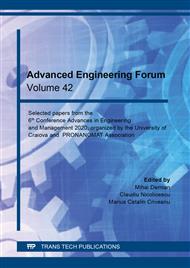p.24
p.30
p.36
p.42
p.50
p.57
p.63
p.71
p.79
Influence of the Polymer Addition in Quenching Water on the Deformation and Residual Stresses of Aluminum Alloy Sheets
Abstract:
The quenching is one of the most used mechanisms for increase the strength of aluminium alloys sheets. The purpose of quenching is to keep the super-saturated solid solution formed during the solution heat treatment as intact by rapid cooling. In order to establish the influence of the addition of polymer in the quenching water on the distortion and residual stresses of the aluminium alloy sheets, several tests were performed with different concentrations of the polymer in demineralized water. The experiments were performed on 6082 aluminium alloy sheets with a thickness of 5 mm. The quenching of the samples was done by immersion in a stainless steel vessel with a capacity of 10 liters. The obtained results show that the addition of polymer in demineralized water positively influences the deformation of aluminium alloy sheets. In this way, a correlation between the polymer concentration and the deformation of the plates was established. Regarding the internal stresses, no correlation was identified with the level of polymer used in demineralized water.
Info:
Periodical:
Pages:
50-56
Citation:
Online since:
September 2021
Keywords:
Price:
Сopyright:
© 2021 Trans Tech Publications Ltd. All Rights Reserved
Share:
Citation:


